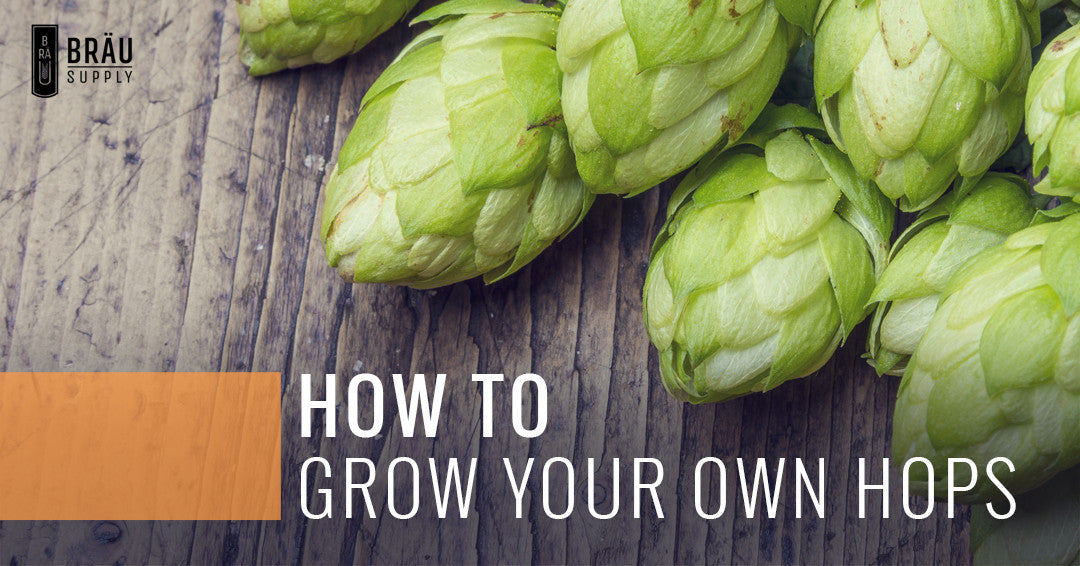Boxing weekend sale! Save up to $700! Shop now Our products ship tariff free

How to Grow Your Own Hops
May 15, 2017 4 min read

Many homebrewers are not lucky enough to live close to a homebrew supply store, and therefore, have to rely on the internet for all their ingredients. This can mean that they can end up wasting their time and money when their malts, hops, or yeast are not fresh enough for brewing. To address this predicament, many homebrewers have started growing their own hops! Regardless of whether you live in sunny Florida, dry Colorado, or the muggy Midwest, hops can be grown in any moderate climate if you care for it properly.
Finding the Materials
It is quite easy to start growing your own hops if you know what you are looking for. First, you need to locate some rhizomes. Rhizomes are the foot-long, root-like cuttings from which hops grow. It is easy to find rhizomes online or at your local homebrew supply store, if you have one. A quick Google search should help you find what you need.
Choosing a Location for Your Hops
Once you have acquired your rhizomes, it is time to determine the best location in which to grow your hops. It is key to plant them in a sunny area where they will be able to get a minimum of six hours of direct sunshine a day. This means that it may be best to plant your hops on the southernmost side of your home. Hop vines (known as bines) can grow to be more than 25 feet tall and weigh more than 20 pounds, so it is best to plant them on a trellis. They need their soil to be well-aerated, nutrient-rich, and be able to drain well. If you choose to grow multiple varieties of hops, keep them separate in the garden, as the roots can spread and take over your entire garden if you allow them to grow together. Make sure to trim the roots every season for this same reason.
Planting Your Hops
The ideal time to plant hops is in the spring after the risk of frost has subsided. Make sure that the soil is highly fertilized before you plant them. Plant your rhizomes in a mound and aerate the ground to help the plants grow quickly and free of disease. Place the rhizomes about four inches deep with your mound roughly a foot high (this will help drainage) with the root side down. You can prevent weeds by covering the mound with straw or mulch. As stated above, hops need a trellis in order to grow properly. There should be some sort of rope or twine going down our trellis from your roof to the ground, or you can use poles instead so that the bines have something to hold onto. Remember that hops grow tall and are rather heavy, so you want to make sure that your trellis is strong enough to support them.
Additionally, you need to make sure your hops get sufficient sunshine and water. If your climate is particularly dry, you may need to water your hops every day. Once your hops have started to grow, you should begin training the bines by wrapping them around the trellis. Eventually, after a few days of training, they will naturally start to wrap around the trellis themselves. Any bines that are weaker and don’t grow around the trellis should be trimmed.
Harvesting Your Hops
If all goes well, your hops will be ready for harvesting in the late summer. The first year, you may not yield many plants, as hops are not inclined to peak at this time. However, you should be able to harvest some. Examine the cones of the hops to determine at what point it is time to harvest your hops. Your hops have reached maturity if they are dry, springy, smell strongly of hops, and leave behind yellow powder on your hands. Check the cones every once and awhile until you think they are ripe, then open one. It should be filled with that yellow powder if it is ripe. While your hops may not ripen simultaneously, it is important to harvest them as they ripen. Dry them out by placing them in a dry, warm place in our house in a paper bag away from sunlight, as sunlight can cause damage to hops once it is picked. Within a week or so, your hops should dry out. After they are completely dry, place them in a sealed bag, and store them in your freezer, being careful to avoid oxidization by completely ridding the bag of air.
Maintaining Your Hops
After you have harvested your hops, cut your bines back about three feet. In the winter, the bines will be killed, and you should cut them more and cover them until spring returns. Once spring arrives, trim the roots to prevent hops from spreading too rapidly. Top off the fertilizer and mulch, and get ready to start the cycle all over again.
Growing your hops at home will make you feel that much more accomplished about your homebrewing efforts. Looking to invest in a new, high-quality home brew system that will help you produce repeatable results? Shop Bräu Supply! Our high-quality brewing systems have everyone talking. Visit this page to shop our home brew systems today.
More articles how to brew beer
The ultimate guide to Kveik yeast: Unleashing it's fermentation potential
Revolutionizing home brewing: The simplified art of no sparge brewing
Exploring amber ales: A guide with a twist on the traditional recipe
Mastering cold crashing: Enhancing beer clarity and accelerating the aging process
What is the basic function of the fermenter?
What causes a fermenter to heat up?
The art of lagering: A guide to perfecting the cold conditioning process
Troubleshooting fermentation problems in brewing: A comprehensive guide
Subscribe
Sign up to get the latest on sales, new releases and more …

